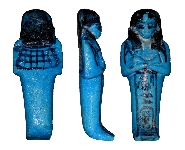

|
|
|||||||||||||||||||||
|
2181 BC
|
2040
|
1782
|
1570
|
1070
|
525
|
332
|
30 BC
|
|
|||||||||||||
|
|
|||||||||||||||||||||
|
|
|
||||||||||||||||||||
|
|
|||||||||||||||||||||
|
|
|||||||||||||||||||||
|
Third Intermediate Period
By the Third Intermediate Period (1069-525 BC) numbers of shabtis increased dramatically although they became smaller in size. The figures wearing
the dress of daily life during the 19th and 20th Dynasties evolved by the 21st
Dynasty into
‘overseer’ figures. Although still wearing a short-sleeved tunic, kilt and triangular
apron, these are distinguished by carrying whips in their hands
(1). Each ‘overseer’ was supposed to supervise ten mummiform ‘worker’ shabtis. The appearance of the whip perhaps suggests that the shabtis figures were now being considered as slaves or servants rather than deputies.
The prescribed number of figures was 401 comprising one
shabti for every day of the year and 36 ‘overseer’ figures, one for every 10 workers. Usually made of blue glazed faience, they
were rather crudely made in open moulds, and the sides and back were usually
trimmed flat.
Two notable additions to the appearance of shabtis during this period were the seshed head-band during the reign of Theban High-Priest Masaharta (2) which was regarded as an aid to resurrection, and the modelling of breasts on
female worker shabtis
(3). Again these elements were copied from coffins of the period.
The inscriptions on shabtis of the Third Intermediate Period are usually very brief, only giving the
Osiris-name and title of the deceased. The figures were still placed in
shabti boxes although these were usually more simple in design and devoid of the
sometimes lavish decorations of the New Kingdom.
|
|
||||||||||||||||||||
|
|
|||||||||||||||||||||
|
1. Faience 'overseer' shabti for Djed-Khonsu
Third Intermediate Period, 22nd Dynasty c. 945-715 BC
|
|
||||||||||||||||||||
|
|
|||||||||||||||||||||
|
|
|||||||||||||||||||||
|
|
|||||||||||||||||||||
|
|
|||||||||||||||||||||
|
2. Faience 'overseer' shabti for Djed-Montu-iwef-ankh clearly showing the seshed headband
Third Intermediate Period, 22nd Dynasty c. 945-715 BC
|
|
||||||||||||||||||||
|
|
|||||||||||||||||||||
|
|
|||||||||||||||||||||
|
|
|||||||||||||||||||||
|
3. Faience shabti for Maat-ka-Re showing breasts just below the lappets of the wig
From Thebes, Deir el-Bahri
(DB 320 - Cache I)
Third Intermediate Period, 21st Dynasty c. 1069-945 BC
ex Henry Wallis RWS collection (1830-1916)
|
|
||||||||||||||||||||
|
|
|
|
|
|
|
|
|
|
|
|
|
|
|
|
|
|
|
|
|
|
|






























